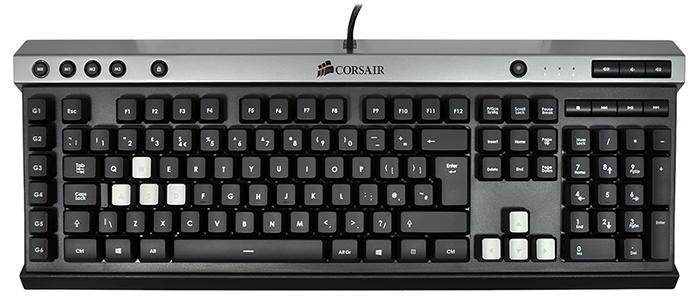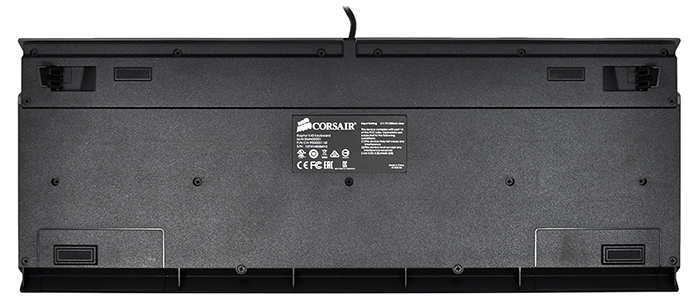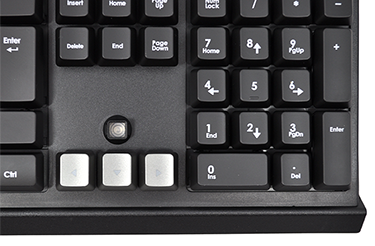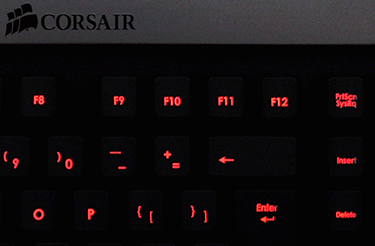Mechanical, Schmanical
If you're in the PC gaming peripheral business, now's a good time to be making a mechanical keyboard. Typically armed with a Cherry MX switch, said boards have become hot property for enthusiast gamers seeking precise actuation, fast response and maximum durability.
Corsair dived into the market successfully with its Vengeance range of hardware - you can read our review of the Vengeance K70 over here - but while mechanical keyboards have their plus points, they aren't for everyone. Prices start at around £60 and rise to well over £100, making them premium pieces of kit, and more importantly, not all gamers take fondly to the clickety-clackety feel of mechanical key switches.
The peripheral business is all about choice and Corsair has attempted to bridge the gap between cheap-and-cheerful and high-end mechanical with a mid-range, rubber-dome keyboard series dubbed Raptor.
Arguably the most interesting among the Raptor range is the K40, which offers the styling of a Vengeance board, an array of gamer-specific features and multi-coloured backlighting, but without mechanical keys. By using a rubber-dome keyswitch throughout, Corsair is able to cut the cost of the K40 and position the board as a good value, mid-range solution.
Though, good value is in the eye of the beholder. At launch a couple of months ago, the Raptor K40 arrived on the scene priced at £59.99 - a figure that we feel was too close to an array of competing mechanical boards. The price tag has since tumbled and shopping around today reveals that the same keyboard can be found for £39.99, making it a far more attractive proposition to casual gamers.
Design
Maintaining continuity throughout its range, Corsair has styled the Raptor K40 to look a lot like its premium Vengeance K-Series siblings. The main tray is black, the keys have a floating appearance and there's a silver trim. The difference here is in material and quality - whereas the Vengeance boards utilise aluminium elements for maximum rigidity, the Raptor is entirely plastic and consequently doesn't provide that ultra-high-quality look and feel.
Build quality is still good, mind you - there's only a small bit of flex if you pick up the keyboard and twist violently - and despite being aimed at gamers, the Raptor K40 isn't too gaudy. It's actually quite attractive in the flesh and the matte finish does a decent job of repelling fingerprints.
We like the fact that dedicated media controls are available, and these include volume up/down and mute on the top-right edge, as well as stop, previous track, play and next track just above the full-size numpad. Small status LEDs for num-lock, caps-lock and scroll-lock mirror what's available on the Vengeance K70, and there's a dedicated backlight button that lets you toggle between three brightness modes - more on that later.
Dimensions of 470mm in length and 180mm in height make the Raptor K40 slightly longer than your average keyboard, and the sparse underside reveals little other than four rubber feet and a pair of standoffs for adjustable rear tilt. Note that the standoffs aren't rubberised - we found the keyboard more prone to unwanted movement when the rear was raised. A single USB 2.0 cable juts out the back and measures roughly 2m in length, but there's no form of cable routing and indeed no USB pass through, meaning you can't connect your mouse conveniently to the keyboard.
Gaming Features
So what's it like to actually game on the Raptor K40? Well, if you don't like mechanical, Corsair's rubber-dome implementation should be right up your street. All the keys are well sized and have a good amount of travel, and they're reasonably quiet in use - they certainly aren't as clicky as mechanical boards.
The arrow keys and WASD are contoured and coloured in grey to stand out from the pack, and there are six programmable 'G' keys lining the keyboard's left edge. What's handy is that these macro keys can be programmed via the keyboard itself. Hit 'MR' (Macro Record), choose the 'G' key you want to assign, then enter your key sequence and hit 'MR' again to save.
Further configuration options are available through software, however the hardware shortcuts work well and there are three available profiles - each with a dedicated 'M' button - allowing users to assign up to 18 macros in total. 36KB of memory is also onboard, so yes, your macros and settings will remain present irrespective of host PC.
The macro keys work well for the most part, however there is one caveat we can think of. The positioning of the 'G' keys will be seen as convenient by some and frustrating by others. Coming from a Vengeance K70, we've become accustomed to Ctrl and Shift being the in the bottom-left corner, as is usually the case, and it takes a while to adjust to these keys being moved over to the next column. Hitting G5 instead of Shift is a regular occurrence during this transitional phase.
As you'd expect from a gaming keyboard, anti-ghosting and full-key rollover are supported, so frantic keyboard bashing won't result in missed strokes, and a Windows Lock key is also present. The keys feel comfortable during use, and we particularly appreciate the way the bottom row tapers off to the shape of your palm.
One of Corsair's key selling points is an RGB backlight mechanism that claims to support 16.8-million colours. Every key is backlit, and with the LEDs positioned at the centre of the rubber-dome switch, the backlighting is more even than it is on most mechanical boards. The only catch is that the illumination doesn't extend to the whole key - take a closer look at some of the longer key labels and you'll notice that parts of the text aren't as bright.













